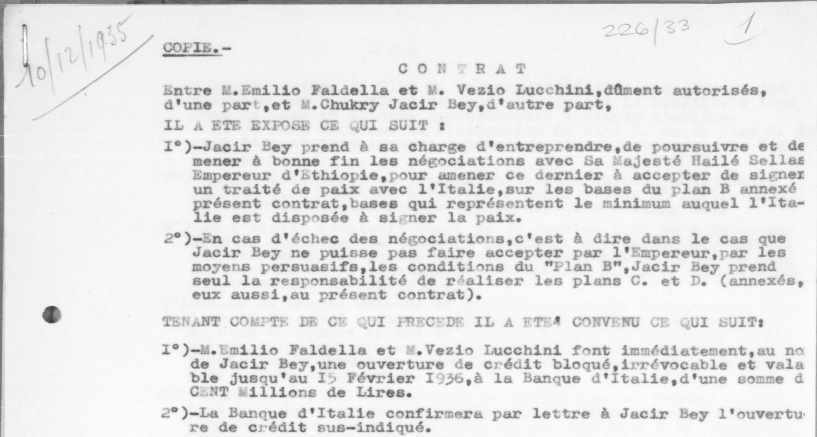Secret peace agreement: Ethiopia, December 1935

This is a copy of the text of a secret contract agreed between Shuqri Jasir bey and two members of the Italian Military Intelligence Service, Emilio Faldella and Vezio Lucchini, in December 1935. It is found in the archive of Abbas Hilmi II (1874-1944), the last khedive of Egypt and who was deposed by the British in 1914.
Ethiopia was invaded by fascist Italian forces in October 1935, but prior to the defeat and exile of Emperor Haile Selassie I in May 1936 there were several international attempts to end hostilities. These sought to unite some Italian gains with existing Italian colonial possessions Eritrea and Somaliland while preserving the nominal independence of a rump Ethiopian state. A Franco-British initiative, the Hoare-Laval Pact, failed a public test when its terms were leaked in December 1935. This less widely-known contract repeats the Pact’s terms but with more forceful contingencies and financial incentives.
Shuqri Jasir bey, a Palestinian financier / adventurer, claimed ties to Ethiopian and Italian diplomatic circles and became a convenient conduit for an Italian diplomatic initiative to contact the Emperor directly. Shuqri Jasir bey had been in contact with Abbas Hilmi II since at least 1922, though why a copy of the contract should have found its way into the former khedive’s archives is not yet known.
Shuqri Jasir bey was tasked to bring Haile Salassie to the negotiating table, and the contract accordingly sets out Italy’s minimum terms (plan B): should peaceful negotiation fail, the convenient inducement of a coordinated Ethiopian military defeat is proposed (plan C), and as a final recourse a plan is sketched out to intercept the Emperor’s aeroplane and force its landing in occupied Italian territory (plan D). The contract also sets out a series of financial incentive payments for each eventuality, none of which in the end came to pass. Plan A is not defined in this copy.
This ‘peace’ initiative and several others subsequently also failed, and whether Mussolini would have long respected the borders of a notionally independent Ethiopian rump state must be doubted. Addis Ababa was occupied by Italian forces in May 1936 and fighting continued until early 1937. Haile Selassie would only return from exile with the support of Allied forces, entering his capital in May 1941.
Though a highly sensitive document in 1935, this contract came to light only ten years later during the war crimes trial of Mario Roatta, in 1935 the Director of the Italian Military Intelligence Service. Roatta escaped to Spain in 1945, and died still at liberty in Rome in the 1960s.
In June 2018 the Mohamed Ali Foundation, which owns the Abbas Hilmi II Papers from which this document is drawn, and Durham University announced the launch of a fellowship programme which will devote scholarly attention to the collection and to make its strengths more widely known to researchers. It is hoped that the fellows’ work will foster deeper understanding of an important period of Egyptian history, and of a transformative era in East -West relations. The first fellow, Dr Pascale Ghazaleh, came to Durham in 2019 and her lecture exploring some of the riches in the collection is now available online. More fellows will be appointed in the next few years, and academic researchers who are interested should look out for annual calls for applications which will be published in June / July.
